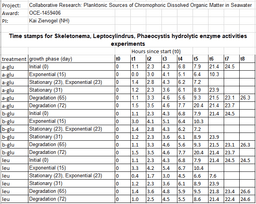| Data File(s) | Type | Description | Action |
|---|---|---|---|
phytoplankton_enzyme.csv (37.41 KB) | Comma Separated Values (.csv) | Primary data file for dataset ID 748423 | |
| Supplemental File(s) | Type | Description | Action |
time_stamp_table.png (41.99 KB)  | Portable Network Graphics (.png) | Hours since start of each experiment (t0) |
Files
Type: Comma Separated Values (.csv)
Description: Primary data file for dataset ID 748423
Supplemental Files
Type: Portable Network Graphics (.png)
Description: Hours since start of each experiment (t0)

